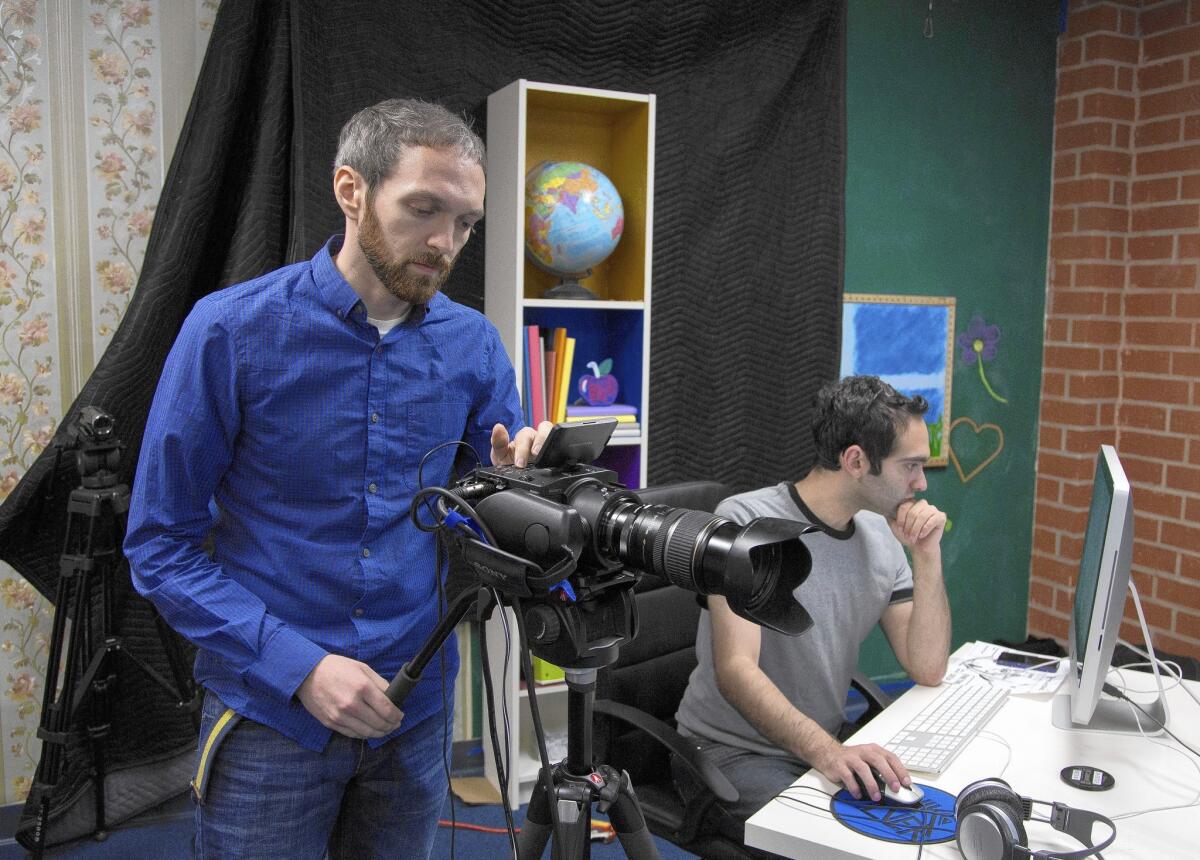Product placements make their way onto viral YouTube videos

- Share via
YouTube stars are borrowing an idea from Hollywood’s Golden Age: product placement.
Think how General Motors sponsored comedian Bob Hope’s variety show, Revlon backed the 1950s game show “The $64,000 Question,” and Milton Berle hosted the “Texaco Star Theater.” They all made money by infusing products and brand names right into the shows.
Taking their cue from TV’s pioneers, the celebrities behind viral videos on YouTube are making deals with sponsors who pay from $5,000 for single videos to just under $1 million for larger campaigns. Digital audiences get turned off by traditional commercials, and YouTube personalities won’t make anything that would drive fans away.
“We couldn’t run the business without brand deals,” Rhett McLaughlin said. “They’re realizing that creating engaging content with their brand integrated is more effective than making a commercial.”
McLaughlin and Link Neal, who have a combined 5.4 million subscribers on their YouTube channels “Rhett & Link” and “Good Mythical Morning,” have inked 15 brand deals in the last 18 months. They have worked with major companies such as Buick, Choice Hotels and Gillette.
The duo keep their audience by telling potential sponsors that their “YouTube channel is not a platform for your commercial.” In a “Rhett & Link” collaboration with Gillette, the razor doesn’t appear until the final 16 seconds of the two-minute video titled “Kissing Your Face: What Women Really Think.”
“A television spot is temporary, but product placement lasts forever,” said Mark Owens, executive vice president of the Branded Entertainment Network, which connects brands to projects. The service is owned by Bill Gates’ Corbis Corp.
Only 2% of U.S. ad budgets is spent on product placement, according to data provider PQ Media. But that is starting to change as dollars drift to digital entertainment from television.
In a March survey of 313 online media buyers, 208 had planned or bought media on YouTube in the last year. Buyers were 49% more likely to say their online video dollars were transitioning from traditional television budgets. The data comes from Outrigger Media, a New York City firm that crunches numbers on ad-supported YouTube content.
Online advertising is expected to top $50 billion this year, according to research firm EMarketer. The amount is expected to hit $66.5 billion by 2016, which will eclipse the amount spent on TV advertising.
“The obligation of the brand is to say, ‘I lost a percentage of my audience to YouTube, and I need to recapture that,’” said Mark Gordon, president of the Producers Guild of America.
Cruise line Royal Caribbean recently announced that it is pulling from its television budget to sponsor two new Web series with AwesomenessTV, the fast-growing network for teens that DreamWorks Animation acquired a year ago in a deal valued at as much as $117 million.
YouTube star Josh Levya of “YoMuscleBoii” hosts “YoMuscleBoii’s Royal Caribbean Adventure,” a travel show aimed at teens. YouTube stars Meghan Rosette, Oli White and Arden Rose are featured in “Shipping Julia,” a six-episode series themed to “Romeo and Juliet.” The cruise line has committed to two seasons of each.
Nestle Purina’s Friskies cat food hooked up with Benny and Rafi Fine of YouTube act “The Fine Bros.,” whose channel has more than 9 million subscribers. They approached Friskies about an April Fool’s feature called “Cats React to Viral Videos,” which has gotten more than 7 million views, nearly 250,000 likes and more than 37,000 comments.
In the video, in which cats stare blankly into space or paw playfully at set props, the Friskies logo doesn’t appear until about four minutes into the five-minute video. The product placement lasts only a few seconds when an orange cat is seen nibbling at a dish of wet food, and then the brand name appears once more in a title card at the end.
“Had that been just a huge commercial, it would not have gone viral,” said Benny Fine, who with his brother is set to produce a “ReactToThat” series for Nickelodeon.
That subtlety had a purpose.
“If you interrupt the story with an unrelated product message, that’s when it doesn’t feel right,” said Shaun Belongie, senior brand manager at Friskies. “You have to ask, ‘What do the Fine brothers bring to life? What are we trying to bring to life? Where is the convergence?’”
Brand deals aren’t always harmonious.
Devin Graham of “DevinSuperTramp,” a YouTube channel with more than 2 million subscribers, was once contacted by a camera company for a collaboration on one of his offbeat outdoor adventures. Graham said he received the cameras the day before the shoot, but the camera was “awful.” He still shot the video after reasoning with the company to pare down the brand message.
“My audience is more important than any brand deal,” Graham said. “If I go in lying about how I feel about a product, my audience can see through it.”
More to Read
Sign up for The Envelope
Get exclusive awards season news, in-depth interviews and columnist Glenn Whipp’s must-read analysis straight to your inbox.
You may occasionally receive promotional content from the Los Angeles Times.







